Museum theft happens. Among the thousands of dedicated professionals that work at museums around the world, there are bound to be rotten apples from time to time. Such thefts don’t often make headlines, but this year, they did.
After nearly a decade of picking up bargains from a supposed Yorkshireman selling on eBay, Danish antiquities dealer Dr. Ittai Gradel found evidence that some of the ancient objects actually belonged to the British Museum.
Gradel informed British Museum staff through a ‘middleman’ in 2020 that objects from the museum were being sold. In late 2022, he contacted a member of the Board of Trustees, who passed the information on to George Osborne, its head. An investigation was begun, but Gradel was already convinced that he’d become an unknowing fencer of stolen goods, buying ancient objects for dirt cheap from a man with a false identity. By tracing the funds he’d sent the seller, he found out that the Yorkshireman, Paul Higgins, bore far too-close a resemblance to the Greek and Roman curator for the British Museum, Peter Higgs.
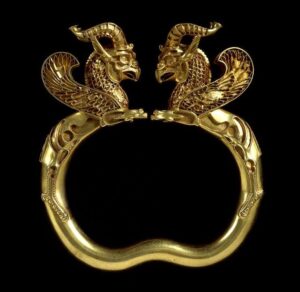
Armlet, gold, Oxus Treasure, Central Asia: Tajikistan: Takht-i Kuwad, 5thC BC-4thC BC, Reg. No. 113944001. © The Trustees of the British Museum. CC BY-NC-SA 4.0 license.
In August 2023, Gradel contacted the Telegraph newspaper and told his story. His public accusation of negligence on the part of the British Museum, and his statement that its Deputy Director had dismissed warnings that pieces from its antique gem collection were being sold on eBay drew much more than headlines. Within days of the story’s publication, the accused curator was fired and the Deputy Director was placed on leave. The museum’s Director, Hartwig Fischer, had stepped back before his planned departure in 2024 to clear the field for further investigation.
The public outcry was overwhelming. Newspapers and television asked what museums were for, except to preserve the objects in their collections. The public wondered if the British Museum had lost its way.
Countries that have sought return of objects from the British Museum in the past were up in arms. Autocratic regimes in Egypt, Turkey, and China that regularly use cultural heritage claims as leverage in domestic politics or to gain international attention, demanded the return of all the objects from their ancient civilizations. Greece asserted that the British Museum was unfit to have custody of the Parthenon Marbles, again. Repatriation advocates were shocked – shocked! – that the museum had failed to catalog every one of the 8 million objects in its inventory.
What do we know about the thefts so far?
Our summary outlines how events unrolled, how the missing objects will be located and recovered, and takes a hard look at how the challenges of collection documentation are being addressed at the British Museum – and elsewhere around the world.
Recently, Ittai Gradel gave an interview to Max Colchester at the Wall Street Journal that detailed his discovery of the thefts from the British Museum. Starting in 2014, Gradel, an academic turned gem dealer, had purchased small but valuable Greek, Roman, and Greco-Egyptian seals and jewelry pieces for very low prices – for example, an agate Roman cameo for £15, a Greco-Egyptian gold ring for £150 – all from a seller on eBay, ‘Sultan1966,’ who called himself “Paul Higgins.”
Sultan1966 claimed to have inherited the antiquities from his grandfather, who had run a junk shop in York and died in 1953. The prices were so low that the seller appeared “clueless” to Gradel, and a man in York with that name had died about that time, so Paul Higgins’ story seemed plausible. But in 2016, Sultan1966 posted a fragment of a cameo that looked somehow familiar, picturing a girl stooping to her right. Gradel was interested, but the post was pulled quickly from eBay. The seller said it belonged to his sister and she didn’t want to sell it, but Gradel had saved the image and held on to it.

The Flood Tablet, also known as The Gilgamesh Tablet from the Library of Ashurbanipal. The Trustees of the British Museum.
Later, Gradel was offered a stone fragment with a profile portrait of a man with an unusual coiffure. He’d seen it offered earlier by Sultan1966 but another dealer bought it and sold it to a third, Malcolm Hay. A few years later, Gradel recalled the portrait’s unusual hairstyle when reading a book by another gem specialist that included an image from a 1926 British Museum catalog. The pieces appeared identical. Going back to his payment records, Gradel saw that the name on ‘Paul Higgins’ eBay bank account was actually ‘Peter Higgs.’ Gradel told another dealer who bought from Sultan1966 about the different names – who was amazed. He told Gradel that Peter Higgs was the name of a curator at the British Museum. Higgs was an unlikely suspect. He had been at the museum for 30 years, had been instrumental in helping authorities to identify looted objects in the past, and lived modestly at Hastings, some 50 miles from London.
Still in doubt, Gradel took his findings to the Reverend Martin Henig, an archaeologist and senior member at Wolfson College at Oxford. Together, they found an object Sultan1966 had offered for sale illustrated in Henig’s copy of the 1926 British Museum catalog. Gradel told Hay, who owned the piece, that it was from the museum. Despite the museum’s closure during the pandemic in 2020, Hay secured a meeting with Deputy Director Jonathan Williams. Hay says Williams put him off with a tale of collections being disturbed during World War II. Williams accepted the gem and thanked him, but neither Hay nor Gradel heard anything further.
That same year, in 2020, Gradel found a color image of the first cameo with a stooping girl that had seemed so familiar on the British Museum’s public access website. He realized that the object must have come from the museum – and recently. It appeared that the museum had done little to investigate and that the thefts were probably still going on. In 2021, Gradel emailed Deputy Director Jonathan Williams to say he had made a discovery regarding theft from the museum. Williams replied that an investigation had confirmed the gems were still in the museum.
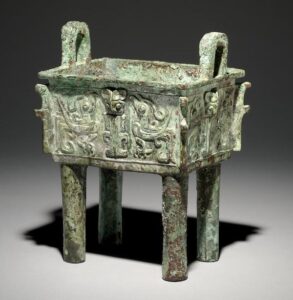
Bronze container, Zhou, ‘Ding’. Bird decoration © The Trustees of the British Museum, CC BY-NC-SA 4.0 license.
At that point, Gradel told Colchester, he made a mistake and told the story to archaeologist Dorothy Lobel King, who, according to Gradel, may have contacted Higgs. It now appears that at the museum, Jonathan Williams had told Director Fischer briefly about the matter, but only that there was not a significant problem and it had been resolved.
Frustrated by the lack of response from upper-level staff at the British Museum and concerned that he was an unwilling participant in a cover-up, Gradel reached out to the Board of Trustees in late 2022, and by early 2023 its chairman, George Osborne, was asking for a new investigation.
According to Gradel, when museum staff checked the inventory of a storeroom where a research collection of small gems and jewelry pieces was stored, they found 935 gems and some 150 minor gold items were missing. On August 16, 2023, the museum made its first public announcement about the thefts. It had launched an independent review led by former trustee Sir Nigel Boardman, and Lucy D’Orsi, Chief Constable of the British Transport Police. The press release stated that a member of staff had been fired and the museum was working together with police on plans to recover the missing items.
When the extent of the thefts became clear, Director Fischer was dismayed. He announced that he was stepping down on August 25, saying that the museum “did not respond as comprehensively as it should have to the warnings in 2021… The responsibility for that failure must ultimately rest with the director.” Although he also hadn’t been kept informed, he felt it would be in the best interest of the museum to let others without current connections to the institution undertake the task of locating the missing objects and repairing the damage. Osborne accepted his resignation, offering praise for Fischer and saying that “No one has ever doubted Hartwig’s integrity, his dedication to his job, or his love for the museum.”
And Gradel? He says that he has carefully gone through his own inventory and collections, and now believes that a collection of 290 gems he purchased between 2010 and 2013 were from the same illicit source. He says his last act will be to return these to the museum.
What is the British Museum doing to recover the stolen pieces?
It appears that over 1000 small, mostly uncatalogued objects from the collection were stolen, missing or damaged. They were all smaller objects of gold jewelry, gems of semi-precious stones and glass dating from the 15th century BC to the 19th century AD. They were largely of Greek and Roman origin, typical examples of the seals, cameos, and small ornaments, including copies of ancient works, that were commonly found in early British collections of antiquities. Such objects came to the museum by the hundreds through bequests and gifts from private collections in the late 19th and early 20th centuries. For over a hundred years, similar objects were accessioned under a series of multi-layered, long-antiquated cataloguing systems. One of these systems, the Secretum, was created in 1865 to hold ‘obscene’ art away from too-susceptible viewers – only ‘gentlemen over 40’ were allowed access.
In the British Museum’s August 2023 announcement, Osborne listed actions taken by the museum.
“We called in the police, imposed emergency measures to increase security, set up an independent review into what happened and lessons to learn, and used all the disciplinary powers available to us to deal with the individual we believe to be responsible.”
In the same public announcement, Director Fischer emphasized the British Museum’s tightened security and its work to build a definitive list of all the stolen items and return them to the museum. The announcement asked for the public’s help in locating the missing pieces.
In partnership with London’s Metropolitan Police Service, the museum has been monitoring the art market with the help of antiquities dealers and listing missing items on the Art Loss Register.

An intaglio similar to those taken. Hellenistic plasma intaglio, engraved with a young warrior seated on a rock, 323–31 BC.© The Trustees of the British Museum. CC BY-NC-SA 4.0 license.
In September, the British Museum added a new Recovery of Missing Items section to its website showing items of similar types to those missing. The museum reached out directly to the public with a request that anyone who believes that they have any of the missing pieces or that items passed through their hands should immediately get in contact to make a report. The museum has not identified specific stolen items based on advice from the Art Loss Register and other “recovery specialists,” believing that this will prevent individuals holding items from being able to identify them and then trying to sell them through illegal channels. By late September, the museum said some 360 objects were returned or on their way back to the collection.
Many would argue that on the contrary, the best thing the British Museum can do is to be completely transparent and publicly identify all the stolen objects they can. Holding back information is the opposite of what the Association of Art Museum Directors has recommended for curtailing illicit trade. The Italian Carabinieri are still withholding information from museums as well as art dealers and auction houses involving 20- and 30-year-old criminal antiquities cases against Italian antiquities looters. Currently, this information is only shared with “antiquities hunters” such as Christos Tsirogiannis. One result of this policy is to enable prosecutors to make highly publicized seizures of artworks from museums and private holders who have no way of knowing that objects are stolen.
The solution lies in thorough documentation and better storage facilities for the collections.
The thefts have highlighted the British Museum’s true immediate needs – – adequate staff and funding for documentation and proper storage. The museum holds eight million objects. For 200 years, its donors have lavished on it gifts of art and artifacts representing all human cultures. Digitization has only existed for a fraction of that time.
For years, the British Museum’s documentation work has been inadequately funded by its Trustees. Former curators have been hired for low-to-no pay – some acting as volunteers – to carry through this important but very time-consuming task.

Installation view, Parthenon marbles in the exhibition Defining Beauty, British Museum. © The Trustees of the British Museum, CC BY-NC-SA 4.0 license.
The British Museum has known for decades that its storage facilities are inadequate, but the pressure is unending. Acres of museum storage space at Blythe House are now being emptied for the building’s sale. The British Museum Archaeological Research Collection (BM Arc) in Shinfield will hold hundreds of thousands of objects in ‘assemblages’ that will contextualize them for public viewing as well as secure them, but much more space is needed.
Documentation is the best way to protect collections from theft or misuse. The British Museum has done an outstanding job with limited resources, digitizing more objects from its collection than the J. Paul Getty Museum, the Metropolitan Museum in NY, or any museum in the world. There are 4.5 million objects already in its online catalogue.
Telling the collections’ stories creatively is equally important. To take just one example, when Covid first hit in Europe and people were forced to stay home from work, the British Museum’s online visitors from Italy jumped to almost 2 million visitors a month, with some of the most popular topics being Ancient Britain, Greece, and Rome. With unique online visits at over 34 million annually, the museum’s websites enable unrivalled global access to art and art history.
Major successes should encourage more funding to the British Museum.
In 2007, the British Museum took over responsibility for the Portable Antiquities Scheme (PAS), a fantastically successful program to encourage reporting of accidental and metal-detecting archaeological finds that has digitally documented over 1,600,000 objects online and inspired hundreds of research projects today.
Important to the success of the Treasure Valuation System behind the PAS has been the collaboration between academics, the trade, and the metal detecting community. It is not the only example. Representative of art trade organizations worked for years with the Egypt and Sudan Department at the British Museum to set up the Circulating Artefacts Database, enabling the museum to secure nearly £1 million of funding for the project. The plan was to put an openly accessible database of Egyptian artefacts in circulation, both to fight illicit trade and protect the rights of private owners. The trade insisted on transparency for an effective database, but the project failed because pressure from the Egyptian government forced the British Museum to exclude trade input and hide the database from public view.
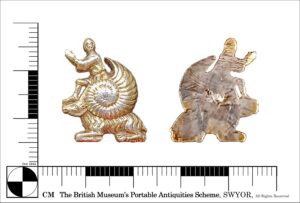
Medieval snail mount, find from the Portable Antiquities Scheme, © The Trustees of the British Museum. CC BY-NC-SA 4.0 license.
The British Museum’s digital archive is a go-to resource for academic research worldwide. More than 4,200 British Museum Athenian vases from its Collections database have been integrated into the Kerameikos.org project funded by the U.S. National Endowment for the Humanities, enabling scholars from around the world to access detailed information for research into Archaic and Classical Greek pottery.
In recent years, the British Museum has accomplished far more than could be expected under challenging circumstances. Despite a gradual recovery after Covid’s 97% drop in admissions, in 2021-2022 the British Museum’s overall income fell by 11% from £123.7m to £109m and fundraising dropped 57%. Nonetheless, under Hartwig Fischer’s eight-year tenure, the British Museum established a masterplan for crucial renovation, consistently produced better exhibitions, borrowed rarer and more spectacular objects from other museums, made loans of artworks to countries where the British Museum had never gone before, and turned stuffy, dusty galleries into brilliant showcases.
The British Museum has catalogued more of its collections than any other museum in the world.
How does the British Museum’s security and documentation compare to collections in countries calling for returns? Egypt, Greek, Turkey, Nigeria, China, and other countries now demanding repatriation cannot compare. The British Museum’s collections are far better documented and more secure.
Egyptian and Greek claims that the British Museum is “irresponsible” and calling for return of the Parthenon Marbles and other treasures are ludicrous. Other countries have done far less than the British Museum to catalog and safeguard their collections. To compare, the new Acropolis Museum in Athens has digitally cataloged 10,557 artifacts; the public can access records of only 2,246 artifacts.
Egypt’s archaeological storehouses have abysmal security and are famed as sources of stolen objects. Egypt’s security and conservation does not come close to international standards. Does anyone remember how in 2015, staff at the Egyptian Museum broke the gold beard off Tutankhamen’s mask and then glued it back on erratically with epoxy?
The Grand Egyptian Museum, built at a cost of $1 billion during the digital age, has about 100,000 artifacts. Its database is not public, so no one can access it. A Global Egyptian Museum database established 15 years ago has cataloged 14,000 objects, of which 1,216 are from Egyptian museums. There is simply no comparison.
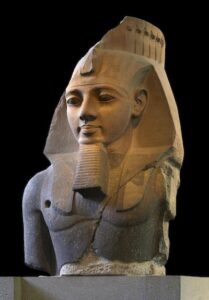
The Young Memnon, The British Museum, London, UK, © The Trustees of the British Museum, CC BY-NC-SA 4.0 license.
The benefits and lessons of digitization are unarguable. Digital Benin, an online resource established in 2020, now shows 5,246 historic Benin objects that can be searched, studied, and viewed. Its catalog also demonstrates that while foreign museums have done an excellent job of preserving Benin artifacts, dozens of important Benin artifacts cataloged by Nigerian scholars in the 1950s and 1960s, including bronzes returned by the British Museum, can no longer be found in Nigerian museums’ collections. They are gone.
There is no excuse for theft from a museum, whether at the British Museum or any other museum around the world. Unquestionably, policies and practices at the British Museum should be amended to address the lapses in communication and documentation that made this theft so hard to discover.
The public trust is impacted by the scandal, but it can be renewed by the museum’s adherence to its first principles of preservation and public access. This theft is profoundly disturbing precisely because the British Museum stands for so much. It is Britain’s finest institution, encapsulating all aspects of Britain’s history, light and dark.
Any theft is deeply damaging. But a theft by a single individual in defiance of all the policies and principles of the institution should not deter us from acknowledging the hundreds of people who work every day to keep the doors of the British Museum open and to conserve, study, and exhibit its collections for the public’s benefit. Nor should this theft be allowed to imperil the institution itself. The British Museum is still the greatest museum in the world.
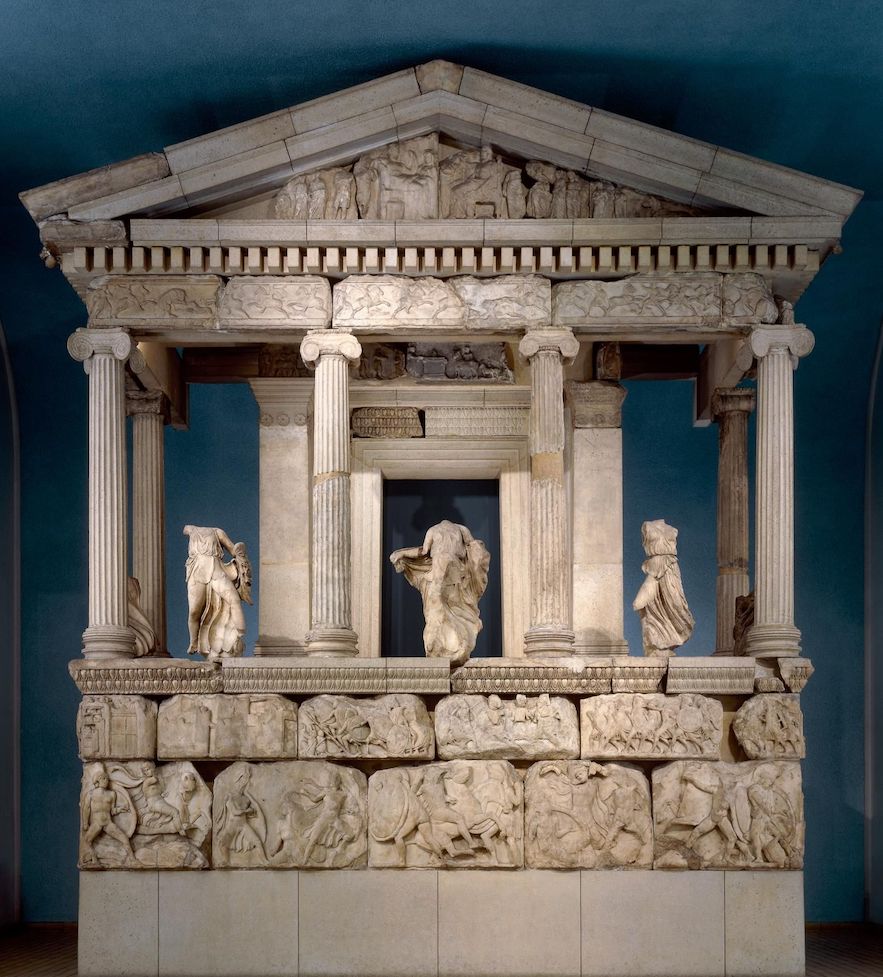 Nereid Monument (Xanthus), marble, 390BC-380BC (circa) excavated by Sir Charles Fellows, 1849, Reg. No. 1848,1020.83. © The Trustees of the British Museum. CC BY-NC-SA 4.0 license.
Nereid Monument (Xanthus), marble, 390BC-380BC (circa) excavated by Sir Charles Fellows, 1849, Reg. No. 1848,1020.83. © The Trustees of the British Museum. CC BY-NC-SA 4.0 license. 

